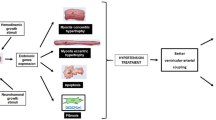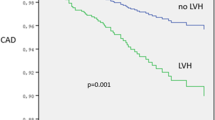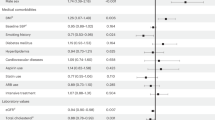Abstract
The predictive value of changes in the severity of electrocardiographic left ventricular hypertrophy (ECG-LVH) during antihypertensive therapy remains unclear in isolated systolic hypertension (ISH). In a Losartan Intervention For Endpoint reduction in hypertension substudy, we included 1320 patients aged 54–83 years with systolic blood pressure (BP) of 160–200 mm Hg, diastolic BP <90 mm Hg and ECG-LVH by Cornell voltage-duration product and/or Sokolow–Lyon voltage criteria, randomized to losartan- or atenolol-based treatment with a mean follow-up of 4.8 years. The composite end point of cardiovascular death, non-fatal myocardial infarction (MI) or stroke occurred in 179 (13.6%) patients. In Cox regression models controlling for treatment, Framingham risk score, as well as baseline and in-treatment BP, less severe in-treatment ECG-LVH by Cornell product and Sokolow–Lyon voltage was associated with 17 and 25% risk reduction for the composite end point (adjusted hazard ratio (HR) 0.83, 95% confidence interval (95% CI:) 0.75–0.92, P=0.001 per 1050 mm × ms (1 s.d.) lower Cornell product; and HR 0.75, 95% CI: 0.65–0.87, P<0.001 per 10.5 mm (1 s.d.) lower Sokolow–Lyon voltage). In parallel analyses, lower Cornell product and Sokolow–Lyon voltage were associated with lower risks of cardiovascular mortality and MI, and lower Sokolow–Lyon voltage with lower risk of stroke. Lower Cornell product and Sokolow–Lyon voltage during antihypertensive therapy are associated with lower likelihoods of cardiovascular events in patients with ISH.
This is a preview of subscription content, access via your institution
Access options
Subscribe to this journal
Receive 12 digital issues and online access to articles
$119.00 per year
only $9.92 per issue
Buy this article
- Purchase on Springer Link
- Instant access to full article PDF
Prices may be subject to local taxes which are calculated during checkout



Similar content being viewed by others
References
Kannel WB, Gordon T, Schwartz MJ . Systolic versus diastolic blood pressure and risk of coronary heart disease. The Framingham study. Am J Cardiol 1971; 27: 335–346.
Kannel WB, Wolf PA, McGee DL, Dawber TR, McNamara P, Castelli WP . Systolic blood pressure, arterial rigidity, and risk of stroke. The Framingham study. JAMA 1981; 245: 1225–1229.
SHEP Cooperative Research Group. Prevention of stroke by antihypertensive drug treatment in older persons with isolated systolic hypertension. JAMA 1991; 265: 3255–3264.
Levy D, Salomon M, D’Agostino RB, Belanger AJ, Kannel WB . Congestive heart failure/LVH: prognostic implications of baseline electrocardiographic features and their serial changes in subjects with left ventricular hypertrophy. Circulation 1994; 90: 1786–1793.
Mathew JM, Sleight PM, Lonn EM, Johnstone DM, Pogue JP, Yi QP et al. Reduction of cardiovascular risk by regression of electrocardiographic markers of left ventricular hypertrophy by the angiotensin-converting enzyme inhibitor ramipril. Circulation 2001; 104: 1615–1621.
Verdecchia P, Schillaci G, Borgioni C, Ciucci A, Gattobigio R, Zampi I et al. Prognostic value of a new electrocardiographic method for diagnosis of left ventricular hypertrophy in essential hypertension. J Am Coll Cardiol 1998; 31: 383–390.
Ishikawa J, Ishikawa S, Kabutoya T, Gotoh T, Kayaba K, Schwartz JE et al. Cornell product left ventricular hypertrophy in electrocardiogram and the risk of stroke in a general population. Hypertension 2009; 53: 28–34.
Koren MJ, Devereux RB, Casale PN, Savage DD, Laragh JH . Relation of left ventricular mass and geometry to morbidity and mortality in uncomplicated essential hypertension. Ann Intern Med 1991; 114: 345–352.
Levy D, Garrison RJ, Savage DD, Kannel WB, Castelli WP . Prognostic implications of echocardiographically determined left ventricular mass in the Framingham Heart Study. N Engl J Med 1990; 322: 1561–1566.
Liao Y, Cooper RS, McGee DL, Mensah GA, Ghali JK . The relative effects of left ventricular hypertrophy, coronary artery disease, and ventricular dysfunction on survival among black adults. JAMA 1995; 273: 1592–1597.
Schillaci G, Verdecchia P, Porcellati C, Cuccurullo O, Cosco C, Perticone F . Continuous relation between left ventricular mass and cardiovascular risk in essential hypertension. Hypertension 2000; 35: 580–586.
Verdecchia PM, Schillaci GM, Borgioni CM, Ciucci AM, Gattobigio RM, Zampi IM et al. Prognostic significance of serial changes in left ventricular mass in essential hypertension. Circulation 1998; 97: 48–54.
Sundstrom J, Lind L, Arnlov J, Zethelius B, Andren B, Lithell HO . Echocardiographic and electrocardiographic diagnoses of left ventricular hypertrophy predict mortality independently of each other in a population of elderly men. Circulation 2001; 103: 2346–2351.
Dahlof B, Pennert K, Hansson L . Reversal of left ventricular hypertrophy in hypertensive patients. A metaanalysis of 109 treatment studies. Am J Hypertens 1992; 5: 95–110.
Devereux RB, Palmieri V, Liu JE, Wachtell K, Bella JN, Boman K et al. Progressive hypertrophy regression with sustained pressure reduction in hypertension: the Losartan Intervention For Endpoint Reduction study. J Hypertens 2002; 20: 1445–1450.
Hypertension Detection and Follow-up Program Cooperative Group. Five-year findings of the hypertension detection and follow-up program: prevention and reversal of left ventricular hypertrophy with antihypertensive drug therapy. Hypertension 1985; 7: 105–112.
Neaton JD, Grimm Jr RH, Prineas RJ, Stamler J, Grandits GA, Elmer PJ et al. Treatment of Mild Hypertension Study. Final results. Treatment of Mild Hypertension Study Research Group. JAMA 1993; 270: 713–724.
Okin PM, Devereux RB, Liu JE, Oikarinen L, Jern S, Kjeldsen SE et al. Regression of electrocardiographic left ventricular hypertrophy predicts regression of echocardiographic left ventricular mass: the LIFE study. J Hum Hypertens 2004; 18: 403–409.
Prineas RJ, Rautaharju PM, Grandits G, Crow R . Independent risk for cardiovascular disease predicted by modified continuous score electrocardiographic criteria for 6-year incidence and regression of left ventricular hypertrophy among clinically disease free men: 16-year follow-up for the multiple risk factor intervention trial. J Electrocardiol 2001; 34: 91–101.
Schlaich MP, Schmieder RE . Left ventricular hypertrophy and its regression: pathophysiology and therapeutic approach. Am J Hypertens 1998; 11: 1394–1404.
The Australian Therapeutic Trial in Mild Hypertension. Report by the Management Committee. Lancet 1980; 1: 1261–1267.
Collins R, Peto R, MacMahon S, Godwin J, Qizilbash N, Collins R et al. Blood pressure, stroke, and coronary heart disease: part 2, short-term reductions in blood pressure: overview of randomised drug trials in their epidemiological context. Lancet 1990; 335: 827–838.
Hypertension Detection and Follow-up Program Cooperative Group. Five-year findings of the hypertension detection and follow-up program. II. Mortality by race-sex and age. JAMA 1979; 242: 2572–2577.
Cutler JA, MacMahen SW, Furberg CD . Controlled clinical trials of drug treatment for hypertension: a review. Hypertension 1989; 13: I36–I44.
Medical Research Council Working Party. MRC trial of treatment of mild hypertension: principal results. Br Med J (Clin Res Ed) 1985; 291: 97–104.
Casale PN, Devereux RB, Kligfield P, Eisenberg RR, Miller DH, Chaudhary BS et al. Electrocardiographic detection of left ventricular hypertrophy: development and prospective validation of improved criteria. J Am Coll Cardiol 1985; 6: 572–580.
Casale PN, Devereux RB, Alonso DR, Campo E, Kligfield P . Improved sex-specific criteria of left ventricular hypertrophy for clinical and computer interpretation of electrocardiograms: validation with autopsy findings. Circulation 1987; 75: 565–572.
Levy DM, Labib SBM, Anderson KMP, Christiansen JCM, Kannel WBM, Castelli WPM . Determinants of sensitivity and specificity of electrocardiographic criteria for left ventricular hypertrophy. Circulation 1990; 81: 815–820.
Molloy TJ, Okin PM, Devereux RB, Kligfield P . Electrocardiographic detection of left ventricular hypertrophy by the simple QRS voltage-duration product. J Am Coll Cardiol 1992; 20: 1180–1186.
Okin PM, Roman MJ, Devereux RB, Kligfield P . Electrocardiographic identification of increased left ventricular mass by simple voltage-duration products. J Am Coll Cardiol 1995; 25: 417–423.
Okin PM, Roman MJ, Devereux RB, Pickering TG, Borer JS, Kligfield P . Time-voltage QRS area of the 12-lead electrocardiogram: detection of left ventricular hypertrophy. Hypertension 1998; 31: 937–942.
Sokolow M, Lyon TP . The ventricular complex in left ventricular hypertrophy as obtained by unipolar precordial and limb leads. Am Heart J 1949; 37: 161–186.
Casiglia E, Schiavon L, Tikhonoff V, Bascelli A, Martini B, Mazza A et al. Electrocardiographic criteria of left ventricular hypertrophy in general population. Eur J Epidemiol 2008; 23: 261–271.
Rodrigues SL, D’Angelo L, Pereira AC, Krieger JE, Mill JG . Revision of the Sokolow-Lyon-Rappaport and Cornell voltage criteria for left ventricular hypertrophy. Arq Bras Cardiol 2008; 90: 46–53.
Dahlof B, Devereux R, de Faire U, Fyhrquist F, Hedner T, Ibsen H et al. The Losartan Intervention for Endpoint reduction (LIFE) in hypertension study: rationale, design, and methods. The LIFE Study Group. Am J Hypertens 1997; 10: 705–713.
Dahlof B, Devereux RB, Julius S, Kjeldsen SE, Beevers G, de Faire U et al. Characteristics of 9194 patients with left ventricular hypertrophy: the LIFE study. Losartan Intervention for Endpoint Reduction in Hypertension. Hypertension 1998; 32: 989–997.
Dahlof B, Devereux RB, Kjeldsen SE, Julius S, Beevers G, de Faire U et al. Cardiovascular morbidity and mortality in the Losartan Intervention for Endpoint reduction in hypertension study (LIFE): a randomised trial against atenolol. Lancet 2002; 359: 995–1003.
Kjeldsen SE, Dahlof B, Devereux RB, Julius S, de Faire U, Fyhrquist F et al. Lowering of blood pressure and predictors of response in patients with left ventricular hypertrophy: the LIFE study. Losartan Intervention for Endpoint. Am J Hypertens 2000; 13: 899–906.
Okin PM, Devereux RB, Jern S, Kjeldsen SE, Julius S, Nieminen MS et al. Regression of electrocardiographic left ventricular hypertrophy during antihypertensive treatment and the prediction of major cardiovascular events. JAMA 2004; 292: 2343–2349.
Anderson KM, Wilson PW, Odell PM, Kannel WB . An updated coronary risk profile. A statement for health professionals. Circulation 1991; 83: 356–362.
Kjeldsen SE, Dahlof B, Devereux RB, Julius S, Aurup P, Edelman J et al. Effects of losartan on cardiovascular morbidity and mortality in patients with isolated systolic hypertension and left ventricular hypertrophy: a Losartan Intervention for Endpoint Reduction (LIFE) substudy. JAMA 2002; 288: 1491–1498.
Cox DR . Regression models and life-tables. J R Stat Soc, B 1972; 34: 187–220.
Kalbfleisch JD, Prentice RL . The Statistical Analysis of Failure Time Data. John Wiley & Sons: New York, NY, 1980.
Kaplan EL, Meier P . Nonparametric estimation from incomplete observations. J Am Stat Assoc 1958; 53: 457–481.
Verdecchia PM, Porcellati CM, Reboldi GMPM, Gattobigio RM, Borgioni CM, Pearson TAM et al. Left ventricular hypertrophy as an independent predictor of acute cerebrovascular events in essential hypertension. Circulation 2001; 104: 2039–2044.
Devereux RB, Wachtell K, Gerdts E, Boman K, Nieminen MS, Papademetriou V et al. Prognostic significance of left ventricular mass change during treatment of hypertension. JAMA 2004; 292: 2350–2356.
Gerdts E, Roman MJ, Palmieri V, Wachtell K, Smith G, Nieminen MS et al. Impact of age on left ventricular hypertrophy regression during antihypertensive treatment with losartan or atenolol (the LIFE study). J Hum Hypertens 2004; 18: 417–422.
Okin PM, Devereux RB, Jern S, Kjeldsen SE, Julius S, Dahlof B . Baseline characteristics in relation to electrocardiographic left ventricular hypertrophy in hypertensive patients: the Losartan Intervention for Endpoint Reduction (LIFE) in hypertension study. The Life Study Investigators. Hypertension 2000; 36: 766–773.
Fyhrquist F, Dahlof B, Devereux RB, Kjeldsen SE, Julius S, Beevers G et al. Pulse pressure and effects of losartan or atenolol in patients with hypertension and left ventricular hypertrophy. Hypertension 2005; 45: 580–585.
Papademetriou V, Farsang C, Elmfeldt D, Hofman A, Lithell H, Olofsson B et al. Stroke prevention with the angiotensin II type 1-receptor blocker candesartan in elderly patients with isolated systolic hypertension: the Study on Cognition and Prognosis in the Elderly (SCOPE). J Am Coll Cardiol 2004; 44: 1175–1180.
Williams B, Lacy PS, Thom SM, Cruickshank K, Stanton A, Collier D et al. Differential impact of blood pressure-lowering drugs on central aortic pressure and clinical outcomes: principal results of the Conduit Artery Function Evaluation (CAFE) study. Circulation 2006; 113: 1213–1225.
Davis CE . The effect of regression to the mean in epidemiologic and clinical studies. Am J Epidemiol 1976; 104: 493–498.
Farb A, Devereux RB, Kligfield P . Day-to-day variability of voltage measurements used in electrocardiographic criteria for left ventricular hypertrophy. J Am Coll Cardiol 1990; 15: 618–623.
Willems JL, Poblete PF, Pipberger HV . Day-to-day variation of the normal orthogonal electrocardiogram and vectorcardiogram. Circulation 1972; 45: 1057–1064.
Zhou SH, Rautaharju PM, Prineas R, Neaton J, Crow R, Calhoun H et al. Improved ECG models for estimation of left ventricular hypertrophy progression and regression incidence by redefinition of the criteria for a significant change in left ventricular hypertrophy status. The MRFIT Research Group. Multiple Risk Factor Intervention Trial. J Electrocardiol 1993; 26 (Suppl): 108–113.
Author information
Authors and Affiliations
Corresponding author
Ethics declarations
Competing interests
The LIFE study (Losartan Intervention For Endpoint reduction in hypertension) was originally sponsored by Merck and Co. Inc., Whitehouse Station, NJ, USA. MHO, RBD, SEK and KW were investigators and RBD, HI, SEK and BD were steering committee members for the LIFE Study. BD, RBD and KW have received grant support from Merck and Co. Inc., the sponsor for the LIFE study. All of the authors (except ACKL) receive occasional speaker honoraria from Merck and Co. Inc.
Rights and permissions
About this article
Cite this article
Larstorp, A., Okin, P., Devereux, R. et al. Changes in electrocardiographic left ventricular hypertrophy and risk of major cardiovascular events in isolated systolic hypertension: The LIFE study. J Hum Hypertens 25, 178–185 (2011). https://doi.org/10.1038/jhh.2010.52
Received:
Revised:
Accepted:
Published:
Issue Date:
DOI: https://doi.org/10.1038/jhh.2010.52
Keywords
This article is cited by
-
Traditional Chinese medicine suppresses left ventricular hypertrophy by targeting extracellular signal-regulated kinases signaling pathway in spontaneously hypertensive rats
Scientific Reports (2017)
-
Regression of ECG-LVH is Associated with Lower Risk of New-Onset Heart Failure and Mortality in Patients with Isolated Systolic Hypertension; The LIFE Study
American Journal of Hypertension (2012)



